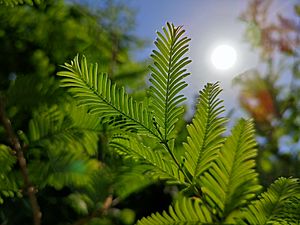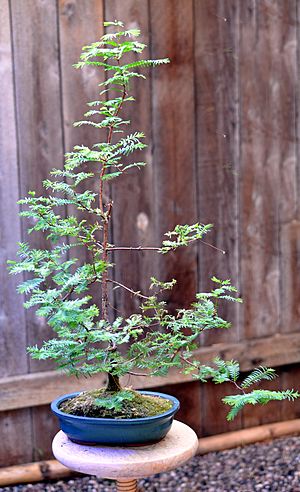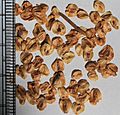Dawn redwood facts for kids
Quick facts for kids Dawn redwood |
|
|---|---|
 |
|
| Conservation status | |
| Scientific classification | |
| Genus: |
Metasequoia
|
| Species: |
glyptostroboides
|
The Metasequoia glyptostroboides, also known as the dawn redwood, is a special type of tree. It's a fast-growing deciduous conifer, which means it's a cone-bearing tree that loses its leaves in autumn, unlike most conifers. It's the only living species in its group, Metasequoia. The dawn redwood is part of the same plant family, Cupressaceae, as other famous redwoods.
Today, you can only find wild dawn redwoods in a small area of south-central China. This includes parts of Hubei and Hunan provinces and Chongqing municipality. Even though it's the shortest of the redwoods, it can still grow very tall, up to 51 meters (167 feet)!
For a long time, scientists only knew about Metasequoia from fossils. They thought it was an extinct tree. But in the 1940s, small groups of living dawn redwoods were found in China. This made it a famous example of a "living fossil" – a plant or animal that was thought to be extinct but was later found alive. Sadly, wild dawn redwoods are still in danger of disappearing because of deforestation. However, people have planted them all over the world in special gardens called arboreta. They are popular because they grow quickly and look beautiful. If this tree hadn't been found when it was, it might have vanished forever.
Contents
How We Discovered the Dawn Redwood
For many years, the dawn redwood was only known from old fossils found across the northern half of the world. Scientists believed it had died out millions of years ago. In 1941, a scientist named Dr. Shigeru Miki from Kyoto University was studying ancient tree fossils. He noticed a unique leaf shape and realized he had found a new group of trees. He named it Metasequoia, which means "like a sequoia."
In the same year, a professor named Kan Duo saw a huge, living tree in China. He was doing a survey in Sichuan and Hubei provinces. He didn't know about Dr. Miki's discovery, but he saw that this tree was very special. He collected some parts of the plant, but he didn't publish his findings. Local villagers called this tree Shuǐshān, meaning "water fir."
Then, in 1943, another scientist named Wang Zhan collected samples from an unknown tree in a village called Moudao in Lichuan County, Hubei. This was likely the same tree Kan Duo had found. Scientists realized it was a new type of tree, but World War II stopped them from studying it further.
The important connection between the fossil Metasequoia and the living tree was made in 1946. Professors Zheng Wanjun and Hu Xiansu figured out that the living tree was the same as the fossil one. They gave it the full scientific name "glyptostroboides" because it looked like the Chinese swamp cypress.
In 1947, a famous garden called the Arnold Arboretum in the United States helped fund a trip. Zheng Wanjun's assistant, Hua Jingchan, collected many seeds from the original dawn redwood tree and other trees in the nearby Metasequoia Valley. These seeds were then sent to gardens and universities all over the world. This helped spread the dawn redwood, making sure it wouldn't disappear.
What Does a Dawn Redwood Look Like?
The leaves of the Metasequoia glyptostroboides are about 1 to 3 centimeters (0.4 to 1.2 inches) long. They grow in pairs directly opposite each other on the branch. They are a bright, fresh green color and turn a beautiful reddish-brown in autumn. The pollen cones (male cones) are small, about 5 to 6 millimeters (0.2 inches) long. They grow on long spikes in early spring. The seed cones (female cones) are round or oval, about 1.5 to 2.5 centimeters (0.6 to 1 inch) across. They have 16 to 28 scales arranged in pairs. These cones take about 8 to 9 months to ripen after pollination.
The dawn redwood's bark and leaves look a bit like another redwood, the coast redwood. However, the dawn redwood is different because it loses its leaves every year, just like the bald cypress. Older dawn redwoods can also grow wide, strong bases at the bottom of their trunks, called buttresses.
This tree grows very fast. In just 50 years, a cultivated dawn redwood can reach over 35 meters (115 feet) tall and have a trunk more than 1 meter (3.3 feet) wide. The trunk often has a unique "armpit" shape where each branch connects. The bark has deep cracks and tends to peel off in long strips.
The largest dawn redwood ever recorded in China was about 50 meters (164 feet) tall and 2.2 meters (7.2 feet) wide. Sadly, it was hit by lightning in 1951 and died. Some other very tall dawn redwoods still live in the Metasequoia Valley where the tree was first found. Even larger trees might have existed, as logs up to 8 meters (26 feet) wide have been found in old rice fields.
The thickest and tallest dawn redwoods in the United States are at Longwood Gardens in Pennsylvania. The widest tree is about 1.84 meters (6 feet) across its trunk. The tallest is about 41.15 meters (135 feet) high. Both these trees were planted in 1948.
Different Types of Dawn Redwoods
Scientists have noticed that dawn redwoods can look a bit different depending on where they grow. These differences are called ecotypic variations. For example, trees growing on mountain slopes might have larger cones and be better at handling dry weather. Trees near streams might have smaller cones and need more water. These variations also affect how fast they grow, their bark, and their leaf color.
Trees Related to the Dawn Redwood
The dawn redwood (M. glyptostroboides) belongs to the same group of trees as the coast redwood and the giant sequoia from California. All three are in the subfamily Sequoioideae, which is part of the family Cupressaceae. While the dawn redwood is the only living species in its specific group, scientists know about three other Metasequoia species from fossils. DNA studies have helped scientists understand these relationships better.
Protecting the Dawn Redwood
Between 2007 and 2009, studies counted about 5,371 wild dawn redwood trees. Most of these are in Lichuan, Hubei, with smaller groups in Shizhu, Chongqing, and Longshan, Hunan.
The Metasequoia Valley in Hubei, where the tree was found, used to be a large dawn redwood forest. It might have looked like the bald cypress forests in the United States. Many other types of plants would have grown there too. Almost 3,000 old tree trunks, some 2 to 8 meters (6.6 to 26 feet) wide, were found in the valley floor. Houses made from dawn redwood wood, 200 to 300 years old, still exist there.
Since its discovery, the dawn redwood has become a symbol of pride in China. It is protected by Chinese law and is planted widely. However, it is still listed as endangered in the wild. It's illegal to cut down these trees or their branches. But people collecting cones for seedlings means that new trees aren't growing naturally in the wild forest. Also, human activity has changed the land a lot. A trip in 1980 found that the natural home of the trees had gotten much worse. Most other plants had been cut down, and the area was no longer good for young seedlings to grow. Between 1950 and 1980, hundreds of trees were cut down in Metasequoia Valley. Some of these were over 2 meters (6.6 feet) wide.
A survey in the 2000s checked all the wild dawn redwoods. Healthy trees were found to be between 25 centimeters (10 inches) and 1.65 meters (5.4 feet) wide. They were 12 to 51 meters (39 to 167 feet) tall and were estimated to be 41 to 265 years old. The average tree was about 27 meters (89 feet) tall and 0.45 to 0.9 meters (1.5 to 3 feet) wide, around 95 years old. No new seedlings were found in the wild. Even if they appear, it's allowed to move them and plant them elsewhere. The dawn redwood will continue to grow in parks and along roads in China. But the natural forest ecosystem where it thrives could disappear if the old trees die without new ones replacing them.
Growing Dawn Redwoods Around the World
Since its rediscovery, the dawn redwood has become a very popular ornamental tree for parks and gardens everywhere.
Seeds arrived at the Arnold Arboretum in the U.S. on January 5, 1948. Soon after, they were sent to other arboreta around the world. By 1951, people could buy dawn redwoods from plant nurseries. News stories, like one in the San Francisco Chronicle in 1948, made the tree very popular, and sales quickly grew.
The dawn redwood is easy to grow in places with mild climates. It is now widely planted as a beautiful tree. Planted trees have already grown to be about 1.84 meters (6 feet) wide and 41.15 meters (135 feet) tall, even though they've only been grown by people for about 70 years. Because it grows so fast, people are thinking about using it in forestry plantations (tree farms). It can even grow well in standing water, like the bald cypress. If left to grow naturally in full sun, its trunk can become wide and twisted, similar to the famous bald cypress.
The dawn redwood can survive cold winters, down to about -25°C (-13°F). It can also handle wet, waterlogged soils, which is how it grows in the wild. However, when it's young, it needs enough water and can struggle in dry conditions. This tree is good for cities in places like the Midwest and East Coast of North America. It grows fast and can handle air pollution, making it a strong choice where other trees might not do well. But in dry places, like the American West, it needs irrigation or to be planted near water. It can also be damaged by a lot of de-icing salt used in winter.
In the 1980s, scientists found that many of the cultivated dawn redwoods had low genetic diversity. This means they were too similar to each other, which could make them more likely to get diseases or have trouble reproducing. Some thought this was because all the original seeds came from just one tree, but this wasn't true. The problem was more likely from trees pollinating themselves when they were planted alone. Still, the cultivated trees had less genetic variety than the wild ones. So, in the 1990s, new trips were made to China to collect more seeds from different wild trees. This helped bring back more genetic diversity to the cultivated dawn redwoods.
Dawn Redwoods in China
Pizhou, Jiangsu province, has the longest dawn redwood avenue in the world. It's about 60 kilometers (37 miles) long and has over one million trees! The Water Forest in Xinghua, Jiangsu is named for the many dawn redwoods growing there.
Dawn Redwoods in the United Kingdom
You can often see dawn redwoods across the UK. They grow fastest in the southeast, but they might do even better in the wetter western parts. The first dawn redwood planted in the UK was at the Cambridge University Botanic Garden. This seed came directly from China, not from the Arnold Arboretum. The tree planted by the lake in 1949 is still alive today! Seeds sent to Hillier Gardens near Winchester in the 1940s have also grown well, and the dawn redwood is now the symbol of those gardens. Some of the tallest trees in the UK are at Woking Park, Surrey, and Wayford Woods, Somerset. There are also different types of dawn redwoods, called cultivars, with various leaf colors and textures. One type, 'Golden Oji', has won a special award for garden plants.
Dawn Redwoods in the United States
Dawn redwoods grow well in a large area of the eastern and southern United States, as well as on the West Coast. Many places, like the Arnold Arboretum at Harvard University, have beautiful examples. The H. H. Hunnewell estate in Massachusetts has two trees from the very first seeds sent out in 1949. There's a small group of dawn redwoods at Bailey Arboretum in New York, including one that some say is the largest by width in the world. The New York City Department of Parks and Recreation has started planting dawn redwoods on sidewalks in Manhattan and Brooklyn. You can even see them on a map online. Washington, D.C. has planted hundreds of them, including all the street trees on Redwood Terrace, NW. A dawn redwood also grows at Rosicrucian Park in San Jose, California, planted in 1950 as a memorial. The Mildred E. Mathias Botanical Garden at UCLA also has one. In North Carolina, some people are working to create a special Metasequoia reserve on 50 acres of land. Portland, Oregon, has some of the oldest dawn redwoods in the U.S. One tree planted in the Hoyt Arboretum in 1948 was the first dawn redwood in the Western Hemisphere to grow cones in millions of years!
Images for kids
-
Displaying autumn foliage in Victoria, British Columbia, Canada
-
A specimen at Croxteth Hall in Liverpool: summer foliage
-
Dawn redwoods in Spokane, WA
-
Metasequoia glyptostroboides in Sagamihara Park
-
Metaseqoia glyptostroboides used as street trees in Eindhoven, Netherlands
See also
 In Spanish: Metasecuoya para niños
In Spanish: Metasecuoya para niños





















